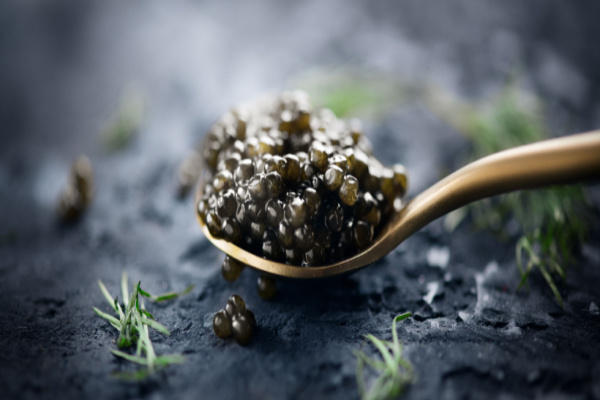Caviar, real caviar, is highly prized, and highly priced, because it’s rare and extremely difficult to harvest. Bursting with salty, nutty, and sweet flavor, caviar instantly elevates any meal’s vibe — this elegant topping can transform boring potatoes or add flair to deviled eggs, which is why you’ll find it on the menus of five-star restaurants around the world.
This cured fish egg or roe, which comes from the sturgeon species, sells for $50-$75 per ounce for domestic roe, and Beluga caviar can go for hundreds, or even thousands of dollars per ounce. It takes seven to ten years for a sturgeon to be mature and ready to produce – and be harvested for – its roe. According to the World Wildlife Fund and the NOAA, Atlantic sturgeon were once found in great abundance, but their populations have declined to the point to where they are now extremely endangered. This is greatly due to overfishing (due to caviar harvesting) and habitat loss.
The often unknown history of caviar is that it was once considered food for the lower classes, as female sturgeons, which were considered bottom feeders, can lay up to 700,000 eggs(though not all of these survive). To reduce food waste, fishermen ate these roe plain or with porridge. When the elite began eating caviar, everyone else followed suit. Today, because of its high price point, the caviar world is rife with knockoffs. Fortunately, it’s easy to distinguish the real thing from the pretenders.
Here is a guide to help you spot Fake Caviar from the Real Deal, from Marky’s Gourmet Food and Gifts.
DIFFERENCES BETWEEN REAL CAVIAR AND FAKE CAVIAR
– Taste: Real caviar tends to be salty and has a distinctively fishy flavor, whereas fake caviar can contain various other types of fish eggs and often tastes extremely sweet.
– Shape: real caviar is typically packed into small spheres or cylinders, whereas fake caviar may come in irregularly shaped pieces which are not uniform in size.
– Price: Real caviar is also much more expensive than fake caviar, due to the fact that it is difficult and time-consuming to produce as well as being high in demand among luxury food connoisseurs.
– Produce: real caviar often comes from wild sturgeon and other fish species, whereas fake caviar is often made from farmed fish or even other types of seafood, such as shrimp.
– Origin: Real caviar is typically sourced from the Caspian and Black seas, whereas fake caviar is often manufactured in countries such as China or Vietnam.
– Appearance: Real caviar has a glossy, silvery sheen, whereas fake caviar tends to be dull and opaque.
– Texture: Real caviar is usually quite soft and mushy, whereas fake caviar can be harder in texture.
– Color: Real caviar comes in a range of colors, including black, red, pink, and yellow. Fake caviar can be any number of other colors as well, such as green or blue.
Many retailers will sell any fish eggs from all types of fish and label those options as “caviar,” legitimately clarifying the species on the tin. And, if you’re fine with that and don’t want to pay for the real thing, caviar substitutes, like salmon roe (which is easier to find), will have a similar effect. If you are lucky enough to get your hands on real caviar, be sure to eat it quickly because the flavors begin to change as soon as the tin is opened. It would be a shame for the expensive delicacy to end up, well, fish food.
—
Photo Credit: Subbotina Anna / Shutterstock.com
